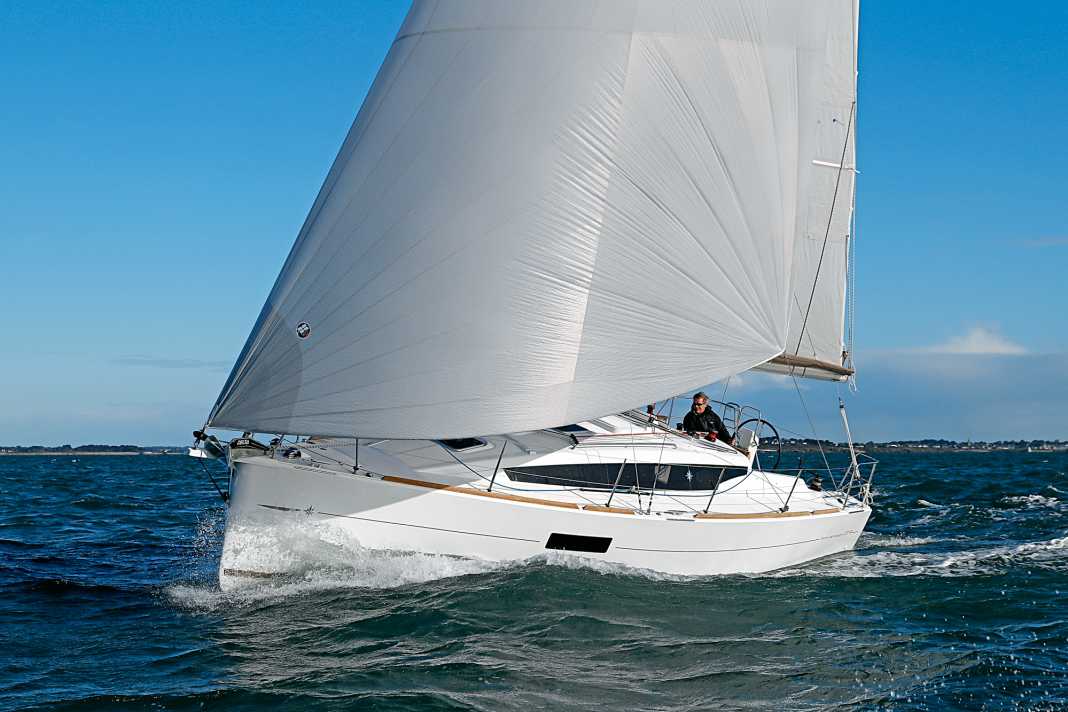





- New ship in a proven hull
- Two keels, different draughts
- The Sun Odyssey 319 under sail
- Below deck
- Attractive price
- The bottom line
- YACHT review of the Sun Odyssey 319
- The Sun Odyssey 319 in detail
- This was the competition for the Sun Odyssey 319 at the time (2018)
- The Sun Odyssey 319 in video
The French company Jeanneau had long and successfully served the entry-level class between nine and ten metres in hull length with the Sun Odyssey 30i and 32i models, but discontinued the range without replacement with the launch of the Sun Odyssey 349 (YACHT 6/2014 test). As a result, however, the shipyard and dealers received an increasing number of requests for an even smaller and, above all, more affordable boat. The then new Sun Odyssey 319 was ultimately intended to fill this gap again.
New ship in a proven hull
But what does "new" mean here? The newcomer was basically an old acquaintance, namely the Delphia 31, which the shipyard in Poland launched on the market in 2012. Jeanneau and Delphia did not comment on the background to the deal at the time. Only this much was known: The French had taken over the moulds and rights from their Polish partner Delphia and reworked the former design by their in-house designer Andrzej Skrzat.
However, the boat was not built by Jeanneau, but continued to be built by Delphia Yachts, now simply on behalf of Jeanneau and under their name and type designation. Such a deal between two of the leading manufacturers and competitors seems unusual today. However, Jeanneau and Delphia already had a well-functioning co-operation back then and for many years before. The French also had their sporty Sun Fast 3200 model built under licence by Delphia in the meantime, and the smaller Jeanneau motorboats from the Cap Camarat and Merry Fisher programmes were also built by Delphia in Poland.
Nevertheless, the decision by industry giant Jeanneau not to present its own new development for the very important entry-level segment has caused some surprise. After all, this class is also about retaining new customers for the brand. However, the approach seemed understandable: The Delphia 31 (YACHT 5/2012 test) had previously proven itself on the market as a robust, honest and no-frills touring boat.
Two keels, different draughts
Jeanneau did not simply take over the design and rebrand it, but also made some very significant changes to it. The hull was given aft chine edges. This was intended to provide stiffer sailing characteristics and modernise the look. The deck has also been completely redesigned. The hull windows have become larger and have adopted the design of the larger sisters from Jeanneau's cruising programme. The superstructure has also been raised slightly. Compared to the Delphia 31, the headroom has increased by several centimetres in all areas.
A new feature was the option of a keel centreboard with reduced draught instead of the fixed keel version with a 1.85 metre deep cast iron fin keel. In addition, the Sun Odyssey 319 was equipped with two short and very robust rudder blades in all keel versions. With this and in the centreboard version, the small Jeanneau should be able to fall dry without any problems, even regularly in tidal waters and without additional mudflats.
The two-saloon rig was largely unchanged from the Delphia boat. However, a new self-tacking jib was offered as an alternative to the overlapping genoa. The revised deck has been reinforced in front of the mast and has also been given a solid foundation for attaching the track for the sheet trolley. The mainsheet is attached in front of the companionway in the form of a cockpit lead. However, Jeanneau no longer offers a traveller in the cockpit; this option was still available on the Delphia 31.
The Sun Odyssey 319 under sail
The conditions could not have been better for the YACHT test in spring 2018 off La Trinité-sur-Mer in Brittany - between 12 and 15 knots of wind, plus a short, albeit steep wave and plenty of sunshine. Equipped with the rollable Code Zero as an extra, the Sun Odyssey 319 got going well from a true wind angle of 90 degrees. The log showed an average of 7.5 knots, and in some crisp gusts it was even almost 8.5 knots.
On the cruising course, the Sun Odyssey 319 sailed quite stiffly, and despite her short hull length, the boat pitched comparatively little in the waves. At a speed of just under 6.0 knots, the small tourer travelled at a good height with a turning angle of around 80 degrees - impressive performance data for a boat of this orientation and size. However, it was important to bear in mind that the test boat, construction number 1, was equipped with the optional performance package. In concrete terms, this meant better laminate sails with a battened mainsail, backstay tensioner and an additional winch on the coachroof for more and better trimming options. The permanently attached bowsprit for the Code Zero or for a gennaker was also only available as an extra at that time.
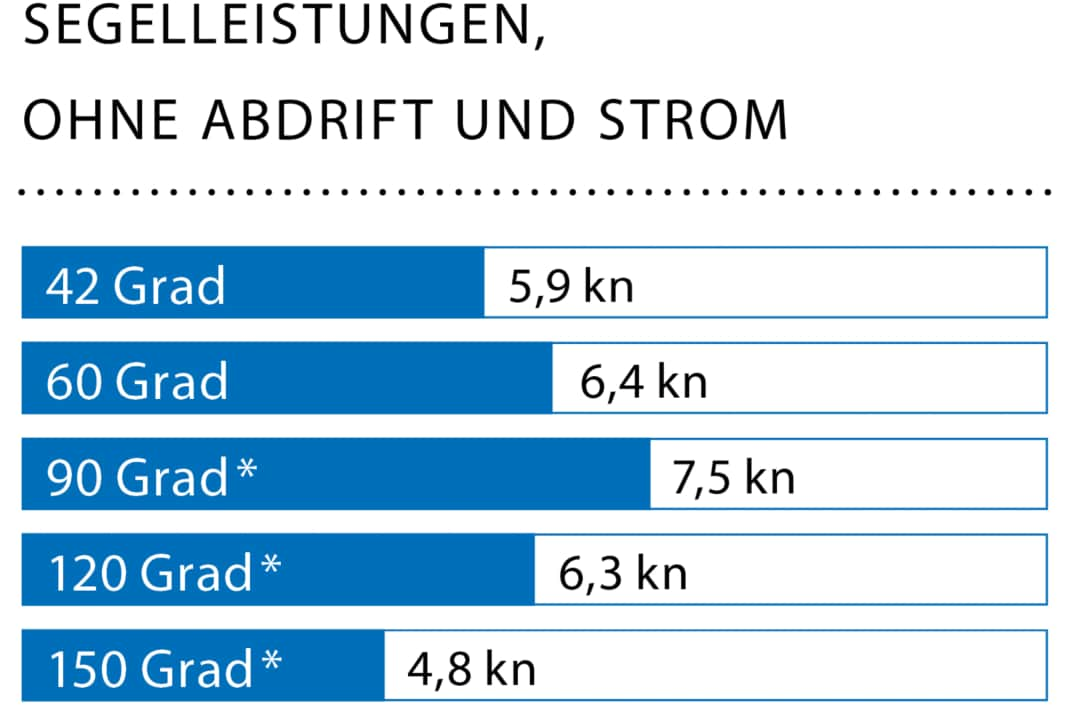



Steering the Sun Odyssey 319 downwind proved difficult and demanding with the new double rudder blades, and on all courses without exception. The test boat, the prototype, reacted unusually directly and quite violently to even the smallest steering movements. The helmsman had to steer very carefully to keep the small boat on course, especially when sailing astern and in waves. At least some rudder pressure was also missing at the cross. Especially with Code Zero, the boat even proved to be slightly leeward, which made steering even more difficult. Close to shore and in shallow water, the boat was calmer on the rudder and easier to keep upwind. The testers at Jeanneau also noticed this behaviour on the construction number 1. After the test with the YACHT, the shipyard therefore wanted to revise the configuration of the steering and rudder again and adapt it accordingly.
Unlike Delphia, Jeanneau no longer offered the tiller as an option - it retained the central steering column, which obstructed the passage through the boat, but still enabled the long dents running through to the stern, on which you could lie out and relax. This set the small Jeanneau apart from the supposedly more modern competitor boats Dufour 310 and Hanse 315, which already featured a wide stern, two steering wheels and a folding bathing platform as an option.
Below deck
Apart from the adaptation of the new hull shape to the Chinese, the hull of the Sun Odyssey 319 remained unchanged; the floor assembly also corresponded exactly to that of the Delphia 31, which meant that the layout of the interior could be adopted. The two separate cabins were each designed to provide enough space for two people to sleep. However, the forward berth was built very far into the bow, which meant that the footwell was only 46 centimetres wide, making it cramped.
Jeanneau has found an exemplary solution for using the sofa berths in the saloon, where the backrests can be removed as whole sections and stowed above. This allows the reclining area to be extended all the way to the outside of the hull. It would have been even better if the backrests could have been folded upwards using hinges. This would even create additional open storage space for bags, for example.
There is no lack of space for equipment and personal items in the boat anyway; there are large and easily accessible storage spaces under the sofas in the saloon and under the berths forward and aft. Only the wet room lacks sufficient storage space. Larger items such as additional sails or a cake stand can be stored in the spacious and deep forecastle locker, which is only accessible from the cockpit. There is also space in the cockpit for fenders and mooring lines.
Light-coloured and additionally bleached beech veneer was used for the interior of the Sun Odyssey 319; no alternatives were offered by the shipyard. The furniture is of good quality, the gaps are correct, and the plywood used appears thicker and more robust than in many other large shipyard series. The floorboards, for example, do not give way noticeably under load or make the usual creaking noises. The installation of the on-board technology also gives little cause for criticism. The electrical cabling behind the switch panel in particular is very neatly laid out and, thanks to continuous labelling, is easy to understand even for laymen.
Attractive price
The Sun Odyssey 319 came onto the market in 2018 for a very attractive base price of €85,205 gross. At around 92,000 euros, the French competitors from Dufour and Beneteau were already a good deal higher than Jeanneau's offer, with comparable basic equipment. Only Hanseyachts was able to undercut the price of the Sun Odyssey 319 with its 315: The entry-level model from Greifswald was already available from 79,000 euros.
As a used boat, the Sun Odyssey is currently (as of February/2025) being offered for between 80,000 and 85,000 euros.
The bottom line
The Sun Odyssey 319 was and remains the good, simple and very functional boat that it was as the Delphia 31. However, the various changes now made by Jeanneau have enhanced the boat even further. In addition, the boat has come onto the market for a very attractive basic price. This would certainly arouse additional interest.
YACHT review of the Sun Odyssey 319
Affordable and attractive entry-level model from Jeanneau. The boat is based on the proven design of the former Delphia 31, but has been completely redesigned in many essential parts.
Design and concept
Robust, well-built tourer
Clear orientation as a family boat
Outdated ship concept
Sailing performance and trim
Surprisingly powerful
Easy handling, suitable for one-handed use
Stubborn steering behaviour (prototype)
Living and finishing quality
Decent workmanship
Sofa bunks with extensions
Little storage space in wet room
Equipment and technology
Impeccably installed on-board technology
No tiller control as an option
The Sun Odyssey 319 in detail
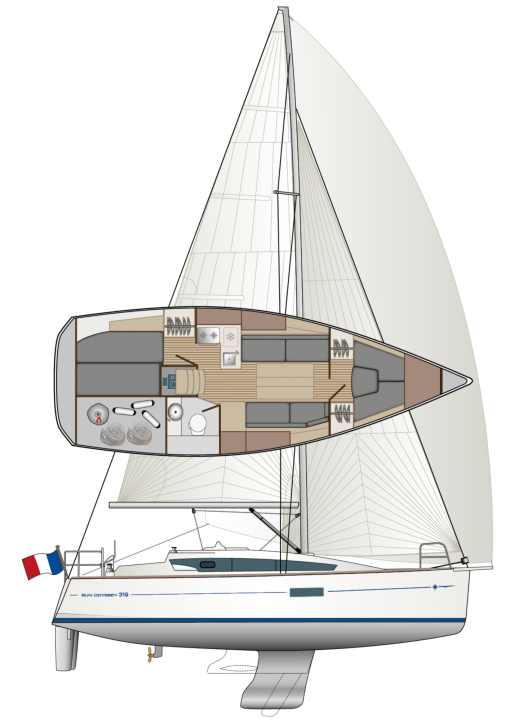
Technical data of the Sun Odyssey 319
- Design engineer: Jeanneau
- CE design category: A
- Torso length: 9,44 m
- Width: 3,46 m
- Low / old: 1,85/0,75-1,70 m
- Weight: 5,1 t
- Ballast/proportion (fixed keel): 1,65 t/32 %
- Mainsail: 23,0 m²
- Furling genoa (110 %): 22,3 m²
- machine (Yanmar): 15 kW/21 hp
Hull and deck construction
Hull: GRP full laminate, deck: GRP sandwich with foam core. Laminated with polyester resin in hand lay-up.
Shipyard
Chantiers Jeanneau; 85500 Les Herbiers/France; www.jeanneau.de
This was the competition for the Sun Odyssey 319 at the time (2018)
Dufour 310
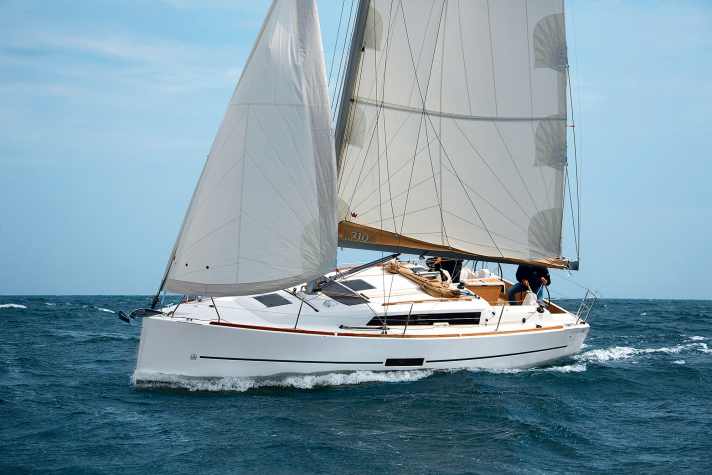
She was the first boat in the class to feature a cockpit with two steering wheels. The modern boat concept has a wide stern with chines and double rudder blades. The folding bathing platform is an option.
Hanse 315
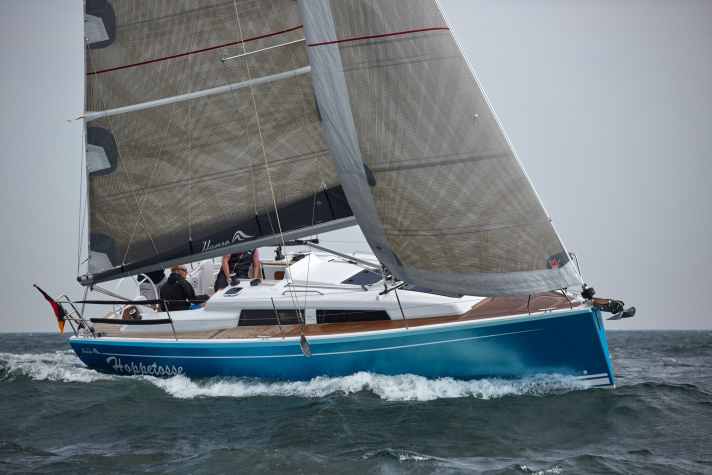
No-frills tourer from Greifswald, which achieved impeccable sailing performance in the test. Available with two steering wheels or a tiller. A wide range of interior design options. To test the Hanse 315.
Oceanis 31
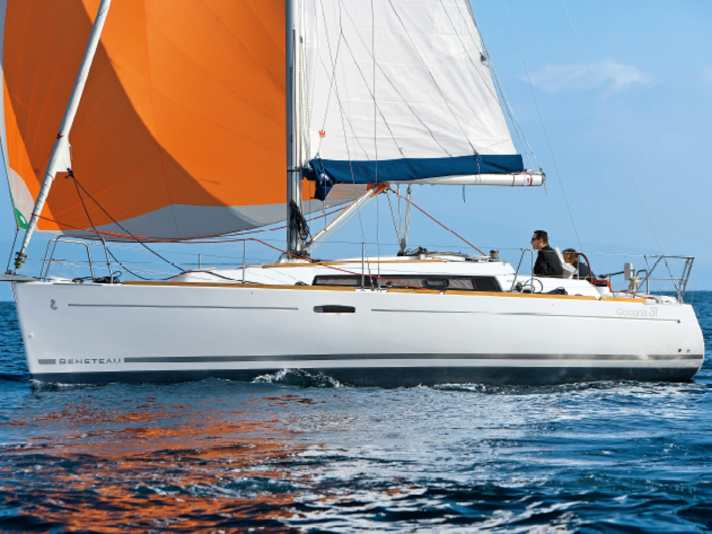
The long and bestseller from industry giant Beneteau. With fixed keel or as a centreboard.
Sunbeam 30.2
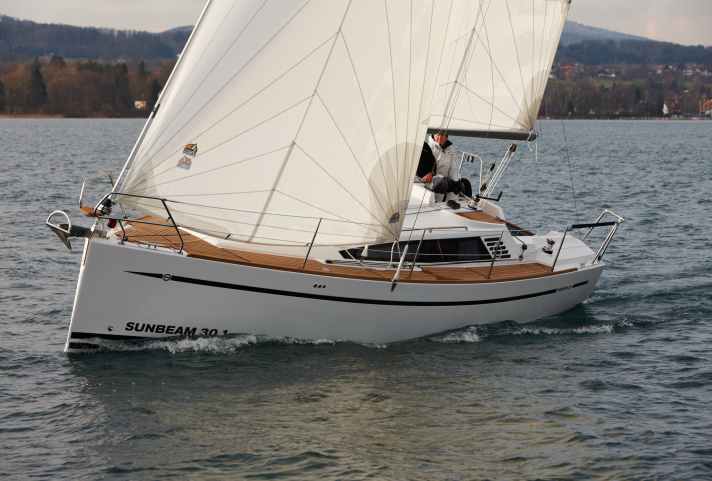
Attractive and relatively slim ship from the Schöchl shipyard in Austria. The high and sporty sail plan ensures great performance potential. The boat comes exclusively with tiller steering.
The Sun Odyssey 319 in video
This test was first published in 2018 and has been revised for this online version.

